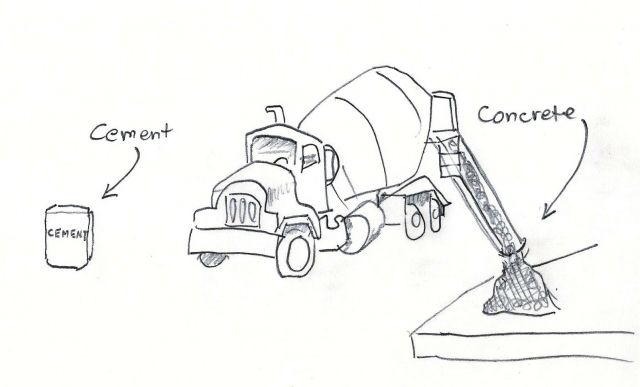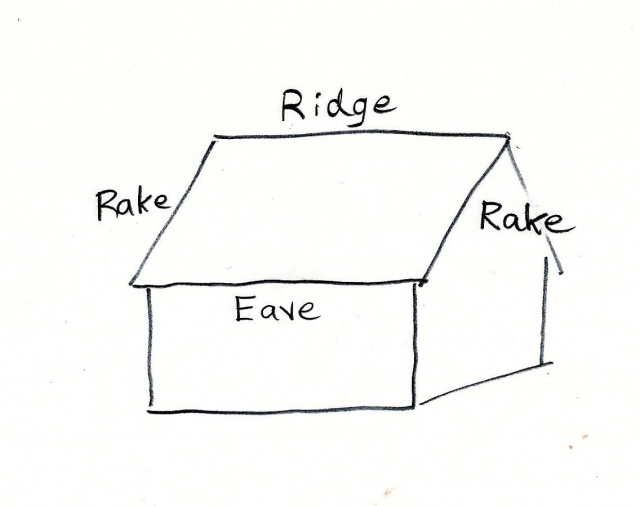
This blog is directed to homeowners. If you are a builder or an architect, you should probably click on a different GBA article.
Homeowners who send questions to GBA sometimes don’t know what to call the parts of their building. (If it’s a diffuser, grille, register, or duct termination, there’s a fair chance that someone will decide to just call it a “vent.”) I’ve rounded up some of the most confusing terms used by builders and architects and clarified their definitions.
Since a drawing can be a handy way to clarify a definition, I made some quick sketches to illustrate my points.
Cement. Don’t confuse cement and concrete. Cement is a powder that is sold in 94-pound bags. Concrete is a mixture of coarse aggregate (stones), fine aggregate (sand), cement, and water.
Wood. The first time I ordered a truckload of 2x6s and 2x10s from a Vermont sawmill, the order was delivered by an elderly truck driver. I politely asked him whether we could put the wood over near a certain apple tree. “Wood?” he said. “Wood is the stuff that you burn in a stove. I’m not delivering wood. I’m delivering lumber.”
Joist. What’s the difference between a joist and a rafter? A joist supports a floor or a ceiling, and is almost always level. A rafter supports a roof, and is usually sloped to shed water.
Beam. A post is vertical. A beam is horizontal. While a joist is usually 1 1/2 or 2 inches thick, a beam is beefier — for example, 6×6, 8×8, or 10×10.
Rake. Most roof slopes have four sides: the ridge, the eave, and two rakes.
Roof. A roof is a structure made up of many components, including rafters, roof sheathing, and roofing underlayment. The roof is the thing…
Weekly Newsletter
Get building science and energy efficiency advice, plus special offers, in your inbox.

This article is only available to GBA Prime Members
Sign up for a free trial and get instant access to this article as well as GBA’s complete library of premium articles and construction details.
Start Free TrialAlready a member? Log in





















12 Comments
I think that a few builders
I think that a few builders should be reading this too. Around here (BC) everyone seems to call concrete cement and that it's delivered to site in a cement truck! I keep trying to explain that cement is an ingredient, but it doesn't always sink in.
Prescriptive vs. descriptive vs. performance based
So now I suppose we can start having debates about prescriptive vs. descriptive linguistics (http://www.ling.upenn.edu/courses/ling001/prescription.html), along with our debates about prescriptive vs. performance-based codes.
Hey, how about performance-based linguistics? By that measure, talking about a cement truck doesn't cause any problems, but saying you are going to put insulation between the rafters when you mean joists or vice versa could certainly be a problem.
And to Ray, when the cement doesn't sink in, that's because the footer is doing its job. Or is that called a footing?
I dunno... (response to Charlie, #2)
Language is a social contract- words mean what the speakers and listeners think they mean. But that's not to say the contracts work for all placed and for all time.
The myriad dialects of the Netherlands & Belgium are at once mutually comprehensible, and mutually confusing, which lead to an international language governing body to define a prescriptive "Algemeen Beschaafd Nederlands" ("General Civilized Dutch", ABN), to standardize spelling & grammar across Dutch/Flemish speaking regions. That's what is taught in schools, and what is used most often in print & broadcast media. But that doesn't mean everybody got the memo on that- there are many regional & local idioms & words that make no sense to people even 100km away, and it's pretty common when travelling outside one's own region to have to ask what something means in "ABN".
Regional dialect & accent differences of North American Anglophones are pretty simple to parse in comparison- even US-Ebonics is usually comprehensible to most Canadians, just as Newfie accents are generally comprehensible to Arizonans, even though may take awhile to tune one's ear to the accents or pick up on the grammatical differences. The same is true for Urdu / Hindi / Punjabi speakers, though local rural dialects can sometimes be pretty opaque, more so than in Dutch / Flemish regions. But unlike the ABN case, there is no international standards body codifying it- it'll always be descriptive, not prescriptive, and that's perhaps the fun of it. The movie industry has a greater influence on standardizing spoken Urdu / Hindi than the academics in Pakistan & India, but it's a in a "living language" sort of way, celebrating the differences rather than prescribing conformity.
We can celebrated the differences too- just don't call a spacing heating appliance using water as the heat distribution fluid a "furnace", or an appliance that only heats potable hot water a "boiler", eh? (What, are we British now? :-) ) And don't call a kilowatt-hour a kilowatt- it drives me crazy! (As if I needed the push... :-) )
Rafter v Truss
We can also explain the difference between a rafter and a truss system. A rafter is typically site built while trusses are typically engineered and pre-built at a manufacturer. Usually you can modify a rafter, but never a truss without an engineer's design. This should be passed on to entry level carpenters, some of the trades as well as homeowners.
Glazing?
The putty that we all used in the old days to fix a broken window is not called glazing; it is called glazing
HUH?
Sill Slope
It may be just a trick of perspective, but it appears to me that Martin's window sill in the drawing is sloping down towards the sash, instead of away. No matter. His words are clear.
That said, what about "cement mixer" for "concrete truck" (even though some concrete mixers are stationary)? Permissible, insofar as the barrel is mixing cement with the other necessary ingredients, or still just plain incorrect? I am willing to concede the latter and change my ways. On the other hand, to my ear, "He got hit by a cement truck" sounds appropriately final, whereas "He got hit by a concrete truck," suggests the possibility -- admittedly vague -- that the victim had a chance of being hit by an abstract truck instead. But I digress . . .
In all seriousness, thank you to Martin for the clarifications and reminders for those of us who know just enough to be dangerous.
Response to Dirk Denzin (Comment #5)
Dirk,
I'm guessing that there is some reason that your computer, tablet, or smart phone isn't displaying all of this article's text. The end of the sentence you quoted must be missing from your display. Here is the full sentence: "The putty that we all used in the old days to fix a broken window is not called glazing; it is called glazing compound."
Response to Bruce Palmer
Bruce,
Thanks for reminding us of the difference between an abstract truck and a concrete truck. It's an important distinction.
And you are absolutely right about the sloppiness of my fast sketches. I didn't use a ruler, and I'm not a draftsman. Over the years, most of my sketches have been made on a 2x6 scrap with a carpenter's pencil...
Concrete Abstracts
Back when finding the the research publications involved using paper-based indexes in a building called a library, "Concrete Abstracts" was the go-to source for many civil engineers. Perhaps the monthly issues were delivered, along with other volumes of abstracts, in an abstract truck?
Dana, I agree about kW vs. kWh. An even clearer marker of confusion is when people say kW per hour, and they are not talking about the ramp rate of a small steam-turbine cogen plant. But what about BTU vs. BTU per hour? Or writing BTUh for BTU/h. Is that simply too rampant to worry about?
Response to Dana Dorsett and Charlie Sullivan
Dana and Charlie,
For more discussion on the issue of energy vs. power and kWh vs. kW, see Understanding Energy Units.
WRB vs vapor barrier!
This one goes for way too many architects, not only homeowners--the generic use of "vapor barrier" when one is (or should be!) just referring to weather-resistant barrier (WRB), which should of course almost always NOT be a vapor barrier. This one is definitely top of my list of pet peeves.
Response to Katy Hollbacher
Katy,
You're right -- there's a lot of confusion out there about (a) whether or not a vapor barrier is needed in a wall assembly, ceiling assembly, or floor assembly, and (b) the purpose of Tyvek and other similar WRBs.
While educated builders and designers can totally eliminate the phrase "vapor barrier" from their conversations (except when talking about a membrane under a concrete slab), the uneducated continue to use the phrase a lot.
Log in or become a member to post a comment.
Sign up Log in